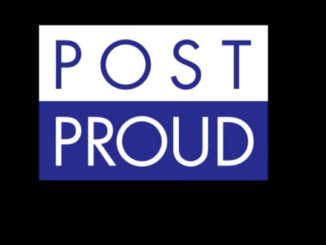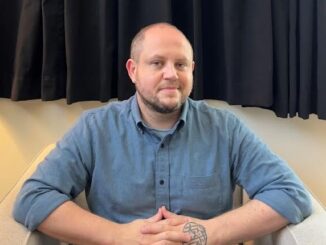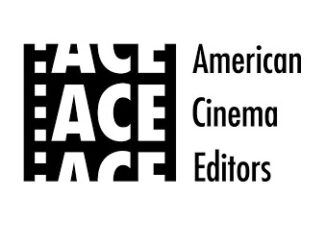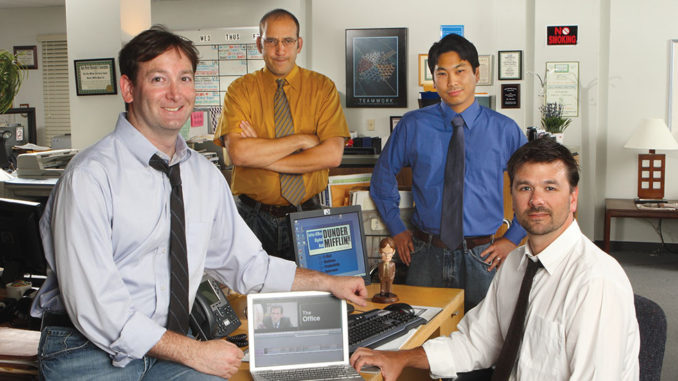
by Robin Rowe
You don’t find too many editors who work “office jobs.” David Rogers and Dean Holland do, however. Only their “office” is The Office, the award-winning NBC comedy series depicting the day-to-day lives of office employees at a Pennsylvania paper company.
The original British series The Office aired on BBC 2 for two seasons beginning in 2001, and won two Golden Globe Awards. The American version premiered as a midseason replacement in 2005. It was adapted for the US by executive producer Greg Daniels, a writer from Saturday Night Live, King of the Hill and The Simpsons. NBC renewed The Office for a full fourth season starting this September.
Unlike many television series, the editors for The Office are located together with the production department on the show’s own two-stage lot in Van Nuys. Editorial is directly downstairs from the writers. CineMontage spoke with Rogers and Holland, along with assistant editor Michael Zurer, about their work on the series. Rogers and Holland won the American Cinema Editors’ (ACE) Eddie Award for Best Edited Half-Hour Series for Television last February and have been nominated for Emmy Awards, including a recent nod for the 2006-2007 season. The Office also received the Emmy Award for Outstanding Comedy in 2006.
“I love to edit,” says Rogers, who was an assistant editor on Seinfeld and News Radio, and later became editor on Andy Richter Controls the Universe; Manhattan, AZ; The O’Keefes; The Mullets; The Comeback; and Entourage. “We have a blast cutting the show.” He and Holland alternate episodes, Rogers reveals, adding, “We each cut our own episodes, but we like to share the finales because they’re an hour long.”
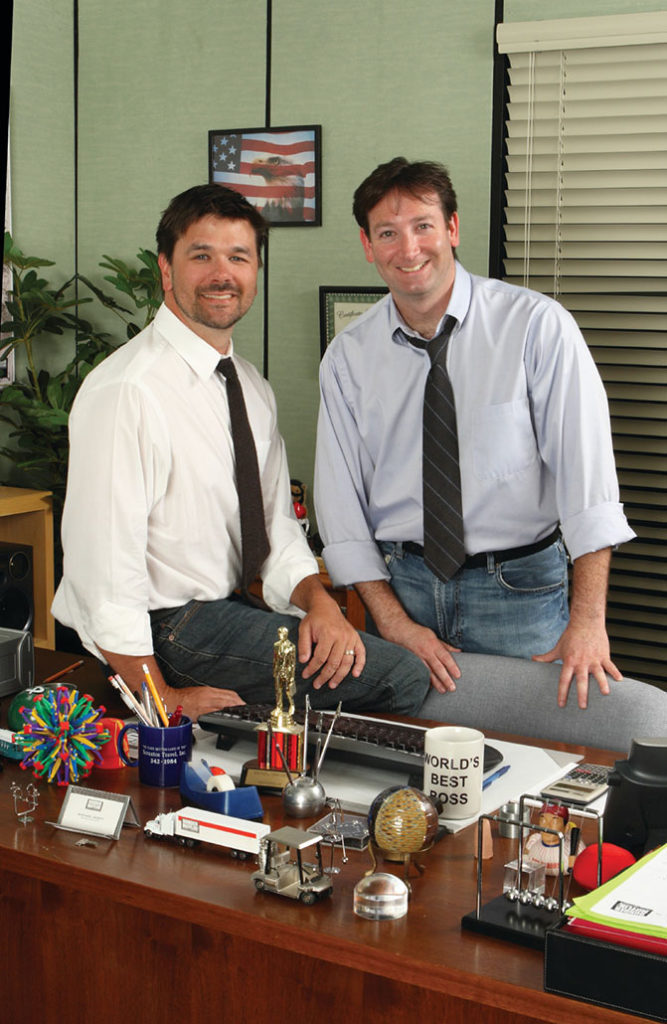
“It’s such a fun job,” concurs Holland, who previously had edited the comedy features Run Ronnie, Run!, The Country Bears and The Hebrew Hammer, as well as Entourage and shows for Comedy Central. “They shoot in our hallway outside where I’m editing all the time. We wear headphones so we don’t spoil the audio when they’re shooting. On any given day, Steve Carell or any of the cast may be in the edit room. Jenna Fischer and Angela Kinsey take breaks in the edit bays all the time,” adds Rogers. “When Steve won his Golden Globe, he came into the edit bay the next day to personally thank Dean and me.”
Editing Challenges
The editors receive a lot of footage, all of it shot hand-held, according to Rogers. “It’s tricky making it all seem cohesive,” he explains. “We have so many great actors to cut to, and they give so much in their performances. But cutting the show can be a challenge.”
The greatest challenge to editing The Office is definitely the amount of footage,” adds Holland, picking up the conversation. “There’s so much good material and 21 minutes and 15 seconds [the length of an episode, sans commercials] is not a lot of time. It means losing sub-plots, story beats and scenes.”
“We have a three-act show, but you can’t just arbitrarily make it seven minutes, seven minutes and seven minutes,” explains Rogers. “It’s cold open, main titles, act 1, break 1, act 2, break 2, act 3, break 3, tag, end credits. And when you get to the commercial break, it has to be this moment of: ‘What happens next?’ Our show is shot in such a way––with the talking heads and limited sets and wardrobe––that many scenes can be re-ordered, changed and even re-written in the edit bay in order to solve a problem or make something work better. Sometimes we do some trickery. We can cross takes in our swish pans. You can’t tell.”
“Our writers usually turn in scripts of 35 to 40 pages,” adds Holland. “Often there are alternate jokes or scenes that are added to that. We shoot it all. That’s the brilliance of the show, because even the long 40-minute assemblies are great. The challenge is cutting it down while maintaining the stories, the humor and the pace. Greg Daniels likes it paced out, not tightened so much that it loses the rhythm.”
During the off-season, the editors cut the DVDs and work on deleted scenes throughout the season. “I don’t look at DVDs as a lesser format,” says Rogers. “The series is immortalized on DVD and I’m very protective of the show to see that certain things get in. It’s the ultimate collection.”
The Avid Systems and Workflow
For The Office, the editors use Avid Media Composer Meridiens on Macin-tosh G4 computers running OS 9, according to assistant editor Zurer. “We have four systems networked to a Unity with about 1.5 terabytes of storage, and we keep the entire season’s media online well after we wrap, doing the DVD special features in the hiatus,” he says. “During the season, the extra systems allow us to get work done during the day while I make a variety of outputs on the fourth Avid. It also allows the night assistant, Donald Joh, to start work as soon as he arrives in the evening to get all the day’s tapes digitized by running captures on the four systems simultaneously.”
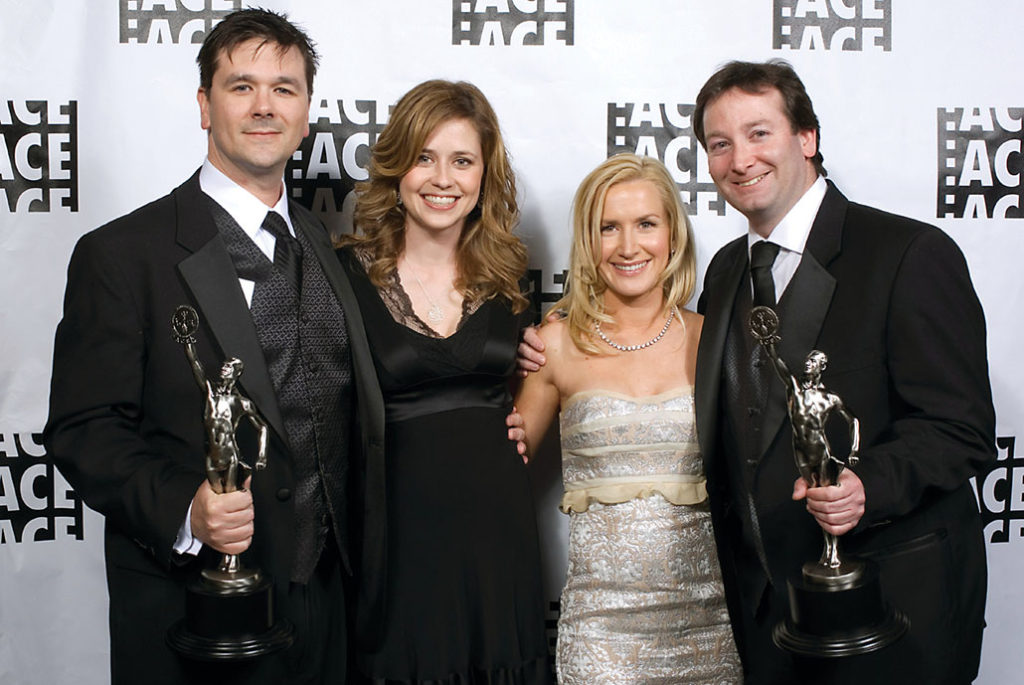
The Office usually has a five-day shoot for each episode. “It is shot with Sony HDW 900 cameras in 23.98 progressive HD. The hour-long episodes take an additional three to five shooting days. “Typically, we get 10 to 16 40-minute camera loads a day,” explains Zurer. “Most of the time, there are two cameras rolling. For ensemble scenes, the directors run anywhere from two to eight takes without stopping the cameras and re-slating. For the interview pieces, there have been as many as 65 takes for a single bit.”
During lunch, the post-production assistant takes whatever camera masters are ready to the finishing house, where the HD masters are transferred to DVCAM editing cassettes. “These start coming back around the time the night assistant shows up, so he can start logging the tapes,” according to Zurer. “We digitize the whole run from ‘action’ to ‘cut,’ group the matching clips, sync them to the audio and then sub-clip these groups into the actual takes. These sub-groups are consolidated onto a workspace on a new drive. The old groups, along with all the dead space between takes, are deleted. All the new groups and clips are renamed using Quick Keys. The editors’ assembly is typically due a few days after shooting, but the time to air varies.”
The sound mixer uses a four-channel hard drive-based recorder from Sound Devices, according to Zurer. There are also lavalier mics on the actors and a boom in the room most of the time. “Because we are using an older version of the Avid that can’t do 23.98 natively, and because the Sound Devices box can’t use-stamp the audio at a rate other than the one at which it was recorded, we use Sample Manager to adjust the audio prior to import,” says Zurer. “Once it is in the Avid and synched to the picture, that audio carries all the way through to audio finishing. Don or I export an OMF that includes all the audio channels. We send that along with all the actual Avid audio media to our sound editor, Bobby Mackston. Once he has it, we can send revisions that link to the media if there are changes.”
“We have a three-act show, but you can’t just arbitrarily make it seven minutes, seven minutes and seven minutes, when you get to the commercial break, it has to be this moment of: ‘What happens next?’” – David Rogers
Editors on the Set
Executive producer Daniels calls the editors to the set frequently. “Whenever they’re re-shooting, he brings us in,” Holland says. “You won’t get that on other shows. The assistant director says, ‘Oh, no, the editors are here.’ She thinks we’re going to slow them down to fix something––which is usually true. We can re-shoot a scene the next day. In two days, it’s cut and in the show. It happens very fast.”
But it isn’t all work. “With the camera rolling between takes, Jenna constantly talks to the camera to give funny notes to Dave and me,” continues Holland. “One time, she was making cracks about the editors.”
Sometimes the actors give the editors more serious notes after a take. “In the Beach Scene episode, Ed Helms and Rainn Wilson are both in swim suits,” recalls Rogers. “Ed tells me, ‘Watch for the take where I was kicking him; that’s funny.’ We were able to log it in as B-roll and show all the best moments of that scene as a montage. We’re here to make the best show.”
And to make more of them. While The Office had a one-hour holiday special and an hour-long finale last year, this coming season there are five one-hour episodes scheduled. Besides the British and American versions of The Office, there are a French Canal+ adaptation, Le Bureau; a Québec version, La Job; and a German series, Stromberg, which was inspired by the original. Taking a hint from The Simpsons Movie, BBC Films is reportedly considering a feature-length version of The Office.


